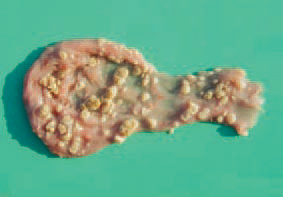|
Diseases of Poultry
By Ivan Dinev, DVM, PhD
|
CANDIDIASIS


401.402Candidiasis is an alimentary tract disease, caused by the fungal yeast Candida albicans and usually occurs as a secondary infection. Predisposing factors are the lack of good hygiene, prolonged antibiotic treatment, vitamin deficiency, severe parasitic infections and immuno-deficiencies. The production of a soluble endotoxin is also contributing to the pathogenicity of the agent. The lesions are usually detected in the crop, lips, oesophagus, but could affect the proventriculus and more rarely, the intestines. The affected mucosa is diffusely or focally thickened, raised and wrinkled, white, resembling a towel. Possibly, the lesions could look as pseudomembranous or diphtheroid coatings. The histological study confirms the diagnosis by showing the fungal hyphae in the affected mucosa. Usually, a 1:2000 copper sulfate solution is used with drinking water for prevention and control. The application of nistatin in water or forage is efficient against candidiasis in turkeys.






